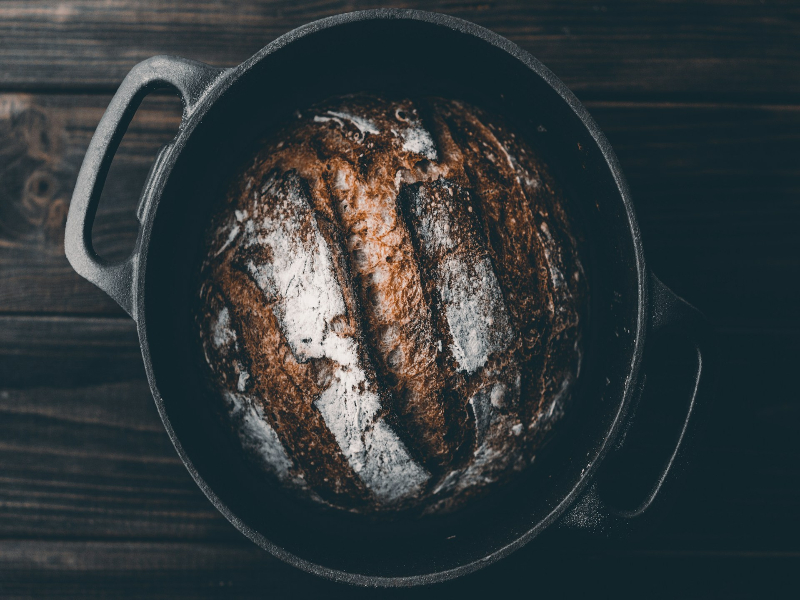
Mesquite Flour
The Taste of Tucson theme of the cooking class was a big hit for our guests. Rockstar Chef Gary Hickey, executive chef/partner at Charro Steak and culinary director for the Flores family of restaurants, created a fun time with a yummy menu.
With lots of deliciousness on the plate, hands-down, they said, the most memorable ingredient was the mesquite flour in the churro.
Duh, I thought to myself. It’s not an everyday item for our Midwestern guests like it is for you and me. And, if your yard is like mine, it’s literally outside the door.
Mesquite flour is the Southwest’s answer to gluten-full woes! It isn’t just any flour; it’s a culinary maverick, a desert-born delight as versatile as it is tasty. It’s a world where cookies hug your tastebuds with a sweet, smoky embrace, and bread rises to the occasion with a nutty, earthy flair.
That’s mesquite’s magical gastronomic homage to the Sonoran Desert, where each bite tells a story, one where the wild, untamed spirit of the desert meets the elegance of whatever you’re making.
And it’s no mere culinary trend. It’s a nod to the rich cultural tapestry of our region, a staple that’s nourished generations. The Tohono O’odham have been tapping into the mesquite tree’s bounty for millennia; now this ancient wisdom fills modern kitchens.
You could become a mesquite maven by shaking a mesquite tree, remembering the golden rule: only take pods from the tree, because ground pods are a no-go—they’re the VIP lounge for bugs and mold. In July, take your pods to Mission Garden’s milling event and you’ll be all set. Or, just buy it.
Mesquite flour is a superfood thanks to its impressive nutritional profile and health benefits: a high-protein, gluten-free alternative to traditional flours, rich in essential minerals iron, calcium, magnesium, potassium, and zinc, all vital for maintaining good health.
It’s low on the glycemic index, making it a great choice for maintaining stable blood sugar levels. Its high fiber content, including soluble fiber, aids in digestion. The flour also contains lysine, an essential amino acid, and other beneficial compounds like tannins and mucilaginous polysaccharides that contribute to its status as a superfood.
Classes
The Thursday, November 21 free AARP-sponsored class, which had been sold out, now has 4 openings. Chef Barry Infuso’s menu dives into autumn’s bounty with three salads: Persimmon & Ginger Pecan, Crunchy Cauliflower with Tahini & Dates, and Boiled Cider Glazed Root Veggies perfectly paired with Spiced Glazed Chicken.
The previously sold-out free AARP-sponsored class on December 5, Sweet Skies Ahead: Sweet Potato Gnocchi, now has 8 openings. You’ll learn the art of making fluffy, pillowy Sweet Potato Gnocchi with nutty notes Brown Butter Sage Sauce and a simple and elegant tomato sauce that won the heart of the legendary tenor Luciano Pavarotti are on Chef Barry’s menu.
Two new free AARP-sponsored classes round out December.
On December 12, Panettone is on Chef Barry’s menu. With the holidays approaching, the Italian sweet bread originally from Milan, is showing up on store shelves. Made months in advance, preservatives keep it soft. Let your tastebuds savor the experience of tasting it fresh from the oven. You’ll learn how to make and bake it in a paper bag, proving homemade is best.
On December 19, discover the versatility of the humble eggplant with Chef Barry as we explore three delectable dishes: the creamy and smoky baba ghanoush, the elegant and refined eggplant caviar, and a quick and easy take on the classic eggplant parmigiana.
Wishing you joy in the kitchen,
Michele
Mesquite Country Bread
3 cups unbleached all-purpose flour
¼ cup mesquite flour
1 teaspoon salt
¼ cup vegetable shortening
1 cup warm water
2 ¼ teaspoons active dry yeast (1 packet)
1. Heat oven to 350°F.
2. In a small bowl, dissolve yeast in warm water and let stand about 10 minutes until frothy.
3. In a large mixing bowl, sift together all-purpose flour, mesquite flour, and salt.
4. Cut in shortening until mixture resembles coarse crumbs.
5. Gradually add yeast mixture to the flour, stirring to form a soft dough.
6. Turn dough out onto a floured surface and knead about 6 minutes, adding more flour if necessary, until smooth and elastic.
7. Place dough in a greased bowl, cover with a damp cloth, and let it rise in a warm place for about 1 hour, or until doubled in size.
8. Punch dough down and shape into a round loaf. Place on a baking sheet or in a Dutch oven.
9. Cover and let rise again for 30 minutes.
10. Bake 20 minutes with the lid on, then remove lid and bake an additional 25 minutes, or until the bread is golden brown and sounds hollow when tapped.
11. Cool before slicing. Enjoy with a hearty stew or as a side to any meal, allowing the unique flavor of mesquite flour to shine through. This bread pairs wonderfully with robust flavors and can be a standout addition to your culinary repertoire.
Photo credit: Arturro on Unsplash




